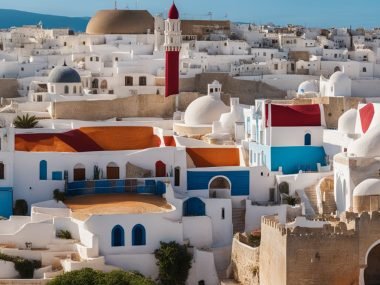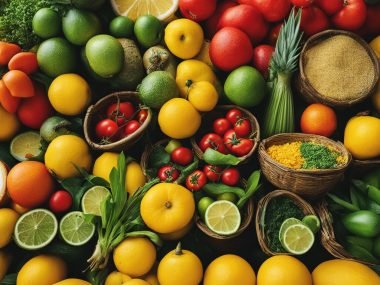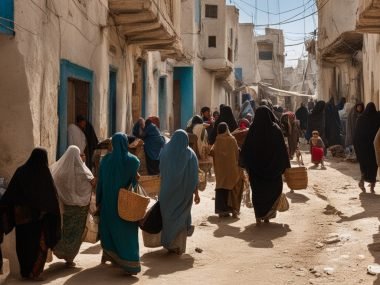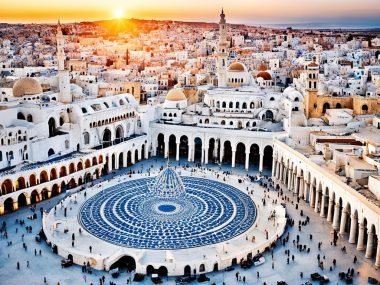Did you know Tunisia might hit a GDP of $53.482 billion by 2024? With about 12.35 million people, this is a big deal. It shows how Tunisia’s economy works. It mixes private business and government rules.
Tunisia loves international trade and working together economically. The Tunisian dinar is their money. They are part of groups like the African Union and the World Trade Organisation. A deep look into Tunisia’s economy reveals key sectors. These are oil, mining, tourism, and making clothes. Farming makes up 10.05% of their GDP. Factories add 21.69% and services are the biggest at 68.26%, all from 2020 data.
Key Takeaways
- Tunisia’s nominal GDP is estimated to hit $53.482 billion by 2024.
- The economic system of Tunisia is a mixed model combining private enterprise and government oversight.
- The country’s economic backbone includes sectors such as petroleum, mining, tourism, and textiles.
- Agriculture, industry, and services collectively shape Tunisia’s GDP composition.
- Active participation in international trade organisations like the WTO and AU enhances Tunisia’s global economic engagements.
- The Tunisian dinar is the national currency facilitating these economic activities.
An Overview of the Tunisian Economy
Tunisia has grown steadily for ten years. By 2024, its GDP per capita should hit $4,136 and $14,294 in PPP. This shows Tunisia’s ability to adapt and be strong.
Current Economic Standing
Tunisia is growing and has faced many global and regional issues. It’s been on a steady path of growth and challenges from 1980 to 2017. Changes in world events and policies have greatly shaped Tunisia’s economy.
Key Industries and Sectors
Tunisia’s economy focuses on oil, mining, textiles, and tourism. These sectors help keep the economy stable. But, the 2015 terrorist attacks showed how vulnerable tourism is. It showed the need to spread out its economic interests.
The 1995 EU Association Agreement boosted trade and investments with Europe. This has really helped Tunisia. Since returning to the international markets in 1992, and uniting the investment code in 1993, Tunisia has opened up. This has been key in making the economy stronger.
The Historical Evolution of Tunisia’s Economic Structure
Tunisia’s economy has grown a lot since it became independent. This growth changed after the Arab Spring.
Post-Independence Economic Developments
In 1956, Tunisia became independent and soon its economy began to grow quickly. The 1970s were especially good, with a big jump in the money made per person. Policies for modernising and opening up the market helped change Tunisia’s economic ways.
But, by the mid-1980s, Tunisia faced a big money crisis with other countries. This led to big changes aiming at opening the market more. These changes, along with help from around the world, made Tunisia’s economy grow again by the late 20th century.
Impact of the Arab Spring
In 2011, the Arab Spring started a big change in Tunisia, affecting its economy and politics. At first, it led to less investment and fewer economic activities. But, determination to improve politics and the economy set the stage for future growth.
However, more people were out of work, and tourism suffered a lot. This was clear after the 2015 attack at the Bardo Museum.
Through ups and downs, Tunisia’s economic ways have kept changing. They have learned a lot from their history.
| Period | Key Economic Event | Impact |
|---|---|---|
| 1956-1979 | Post-Independence Modernisation | Rapid GDP growth, over 380% increase in GDP per capita |
| 1980s | Foreign Exchange Crisis | Initiation of structural adjustments and market liberalisation |
| Late 20th Century | Economic Reforms and Privatisation | Renewed growth and international integration |
| 2011 Onwards | Arab Spring | Economic slump followed by reform-driven rebound |
Composition of Tunisia’s GDP
Tunisia’s GDP includes three main sectors: agriculture, industry, and services. These sectors make the country’s economy rich and varied.
Sectoral Contributions
Tunisia’s economy is diverse. Over time, different sectors have played key roles in the nation’s GDP.
- Agriculture: This sector adds more than 10% to Tunisia’s GDP. It’s important for the rural areas with crops like olives, dates, and citrus fruits.
- Industry: Makes up about 21.69% of the GDP. It includes mining, especially phosphates, and making things like textiles and clothes.
- Services: This is the biggest sector, with 68.26% of the GDP. It includes tourism, banking, and telecoms, showing how crucial it is for Tunisia.
Agricultural, Industrial, and Service Sectors
The Tunisian GDP shows balanced growth. Agriculture not only feeds locals but also supports exports. The industry sector booms from Tunisia’s phosphates, making money and jobs.
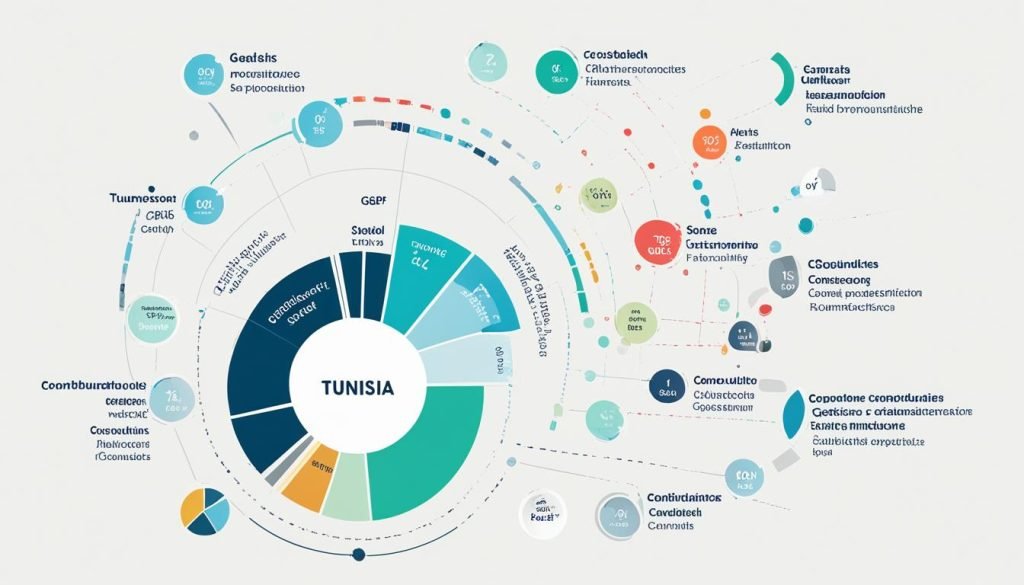
In services, tourism is a key player. It draws lots of visitors each year, increasing income. Banking and financial services also play a major role, making this sector vital for Tunisia.
From 1980 to 2017, Tunisia’s sectors grew at different rates. This shows the economy’s ability to adjust and flourish despite worldwide and local changes.
Economic Policies Shaping Tunisia’s Growth
Tunisia has changed its economic policies to grow and develop. The government is opening up the economy, cutting tariffs, and boosting private business.
Government Initiatives
The big changes started in the 1980s with the goal of opening up Tunisia’s economy. The recent “2023-2025 Government Development Plan” and “Note d’Orientation Tunisie 2035” focus on jobs in the private sector. They also aim to make people more skilled and fight climate change.
International Collaborations
Working with other countries is key. Tunisia’s deal with the EU and its role in the Mise A Niveau programme show its important global links. These actions support the World Bank’s goals for Tunisia’s economic policies.
| Initiative | Objective | Outcome |
|---|---|---|
| 2023-2025 Development Plan | Sustainable development and job creation | Enhanced private sector growth |
| “Note d’Orientation Tunisie 2035” | Long-term economic strategy | Strengthened human capital and reduced climate impacts |
| EU Association Agreement | Deepened international ties | Improved trade relations and economic resilience |
| Mise A Niveau programme | Structural adjustments and competitiveness | Modernised industries and streamlined regulations |
Main Features of Tunisia’s Economic Model
Tunisia has a unique mixed economy. It mixes market actions and government control. This mix helps the economy grow steadily.
Mixed Economic System
The mixed system in Tunisia combines private and public work. The government plays a key role in big areas. Yet, private businesses have a lot of freedom too. This helps everyone in the economy and boosts new ideas.
Government Regulation and Private Sector Freedom
The government in Tunisia looks after important sectors like banking and energy. It sets rules to guide these sectors. At the same time, private companies can work freely. This balance is key for lasting growth.
Recently, Tunisia has started selling state-owned businesses. This move allows more private money and new business ideas. Foreign investments are welcome too. The aim is to make the economy open for both public and private growth.
Challenges Facing the Tunisian Economy
Tunisia faces many economic problems right now. One big problem is the high jobless rate, which is at 15.3%. This makes it hard for the economy to be stable. High prices for things make this worse, hurting how much people can buy.
Too many people are poor, and too much work happens outside of the formal economy. More ragpickers show the depth of these issues. We need plans that help everyone and make the formal economy stronger. This would help those in need a lot.

Relying too much on tourism is risky. This is because tourism earnings can go up and down a lot. It’s important to find other ways to make money and to be ready for tough times.
- High Unemployment Rates: 15.3% as of Q2 2022
- Elevated Inflation: Persistent issue affecting economic stability
- Poverty Levels: Increasing number of ragpickers indicating socio-economic distress
- Informal Economy: Significant portion of economic activity occurring outside formal sectors
- Dependency on Tourism: Volatility necessitates diversification and crisis management
To fix Tunisia’s economic troubles, we need many solutions. These include helping all parts of the economy, making the formal economy bigger, and finding different ways to earn money. This would make Tunisia’s economy stronger and more able to face challenges.
Key Trade Partners and External Trade Relations
Tunisia’s economy is closely linked with other countries. France, Italy, and Germany are its main trade buddies. These relationships are important because of history and closeness.
Tunisia sells many things abroad. Items like clothing, agricultural products, and chemicals are big exports. Diversifying what it sells helps Tunisia deal with global market changes.
Tunisia also works with trade groups to grow its economy. The African Continental Free Trade Area (AfCFTA) and COMESA are two examples. These groups make it easier for Tunisia to trade far and wide.
Tunisia buys a lot from other countries too. Goods range from textiles to machines. Europe and China are where a lot of goods come from. This trade helps Tunisia stay strong economically.
| Country | Major Exports to Tunisia | Major Imports from Tunisia |
|---|---|---|
| France | Machinery, Vehicles | Clothing, Agricultural Products |
| Italy | Textiles, Chemicals | Electronics, Textiles |
| Germany | Vehicles, Machinery | Mechanical Parts, Chemicals |
| China | Electronic Equipment, Construction Materials | Textiles, Shoes |
Role of Financial Institutions in Tunisia’s Economy
Financial institutions in Tunisia help the economy grow and stay stable. These include banks and financial markets. They make sure money and investments flow well.
Banks and Financial Market
The banking sector in Tunisia is strong. Amen Bank is a big name here. The Bourse de Tunis lists more than 50 companies. It is watched over by the government.
This market lets different industries get capital. Financial institutions in Tunisia play a key role. They help with safe transactions, savings, and loans. This supports growth for individuals and companies.
Foreign Direct Investments
FDI is very important for Tunisia’s economy. For example, the ELMED Interconnector project pulls in international money. Financial institutions in Tunisia also help small and medium businesses get funding. This helps the economy grow.
These efforts improve economic development. They do this by creating good conditions and partnerships. This shows how important these institutions are.
| Financial Institutions | Role |
|---|---|
| Banks (e.g., Amen Bank) | Provides essential banking services, credit, and investment opportunities |
| Bourse de Tunis | Facilitates capital raising for diverse industries through stock exchange listings |
| FDI Initiatives | Attracts international investments and aids in economic development |
Conclusion
Tunisia’s journey shows it uses a smart mix of many economic strategies. The country mixes government plans and global partnerships well. This approach helps Tunisia stay strong and grow, even when things get tough.
Tunisia faces big problems like high jobless numbers and too much reliance on tourism. Despite these issues, its economy remains strong. The Arab Spring brought challenges, but Tunisia’s economy has a deep strength.
The future looks bright for Tunisia with help from other countries and new economic plans. Efforts to try new things could make the economy better for everyone. By looking back and planning for the future, Tunisia is making great progress.


